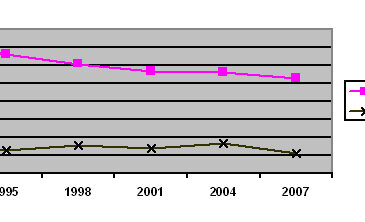It is important to understand how the introduction of new gambling opportunities affects gambling behavior, particularly among young people. This week’s WAGER reports results of a study that collected youth gambling rates every three years from 1992 to 2007 (Stinchfield, 2011).
Method
- The researchers analyzed data from the Minnesota Student Survey (MSS). The Department of Education administered this survey every three years from 1992 to 2007 years to 9th and 12th grade students. The maximum number of students (N = 83, 260) were surveyed in 2007 and the minimum number (N = 73, 897) in 1995.
- The survey included a gambling frequency question (“During the last 12 months, how often have you done these activities”) for various gambling activities (i.e., playing cards, casino, online gambling, sportsbetting, and lottery tickets). The possible responses ranged from “Not at all” to “Daily”.
Results
- Figure 1 shows the consistent decline in any past-year gambling activity since 1992..
- In 2007 66% of 9th grade boys and 33% of 9th grade girls gambled in the past year
- At the same time, the frequent gambling (i.e., gambling at least weekly) was relatively stable over time.
Figure 1. Percent Endorsing any gambling and frequent gambling (at least weekly)
Limitations
- This is a correlational study, therefore it does not explain the causes of the decline.
- The patterns found may reflect some specific Minnesota circumstances and may not be representative of all youth gamblers.
- Gambling activity is based on self-report and may not reflect actual gambling.
Conclusion
This study does not support the claim that growth of commercial gambling opportunities leads to increased gambling in the population. The results show that since the onset and expansion of commercial gambling in Minnesota, the frequency of occasional gambling declined rather than increased. The rate of frequent gamblers remained the same during these years. This implies the lack of causal link between commercial gambling and youth gambling. This study does not provide an explanation for the decline. However, the results are consistent with the “adaptation” concept suggested by the previous research on online gambling (LaPlante & Shaffer, 2007; Shaffer, LaBrie, & LaPlante, 2004). Based on actual gambling data rather than self-report, these studies demonstrated a decline in gambling activity for the vast majority of gamblers after their first exposure to the gambling site.
-Julia Braverman
What do you think? Please use the comment link below to provide feedback on this article.
References
Stinchfield, R. (2011). Gambling among Minnesota public school students from 1992 to 2007: Declines in youth gambling. Psychology of Addictive Behaviors.
LaPlante, DA & Shaffer, H. J. (2007). Understanding the influence of gambling opportunities: Expanding exposure models to include adaptation. American Journal of Orthopsychiatry, 77, 616-623.
Shaffer, H.J., LaBrie, R.A., LaPlante, D.A. (2004). Laying the foundation for quantifying regional exposure to social phenomena: Considering the case of legalized gambling as a public health toxin. Psychology of Addictive Behaviors, 18(1), 40–48.





